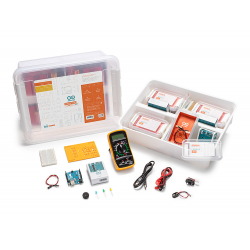
- Send to a friend
-
- Remove this product from my favorite's list.
- Add this product to my list of favorites.
Learn electronics and get started with programming in your classroom step-by-step. The new version of the Arduino kit for beginner programming and electronics learning brings 9 new 90-minute lessons and 2 open-ended projects - educational content for a minimum of 17 school hours. No experience necessary.
























